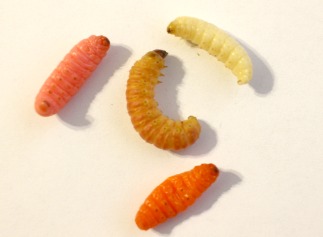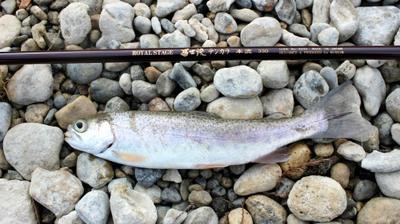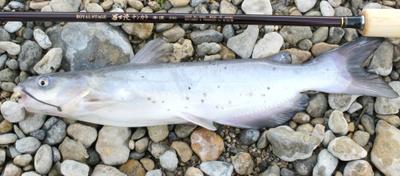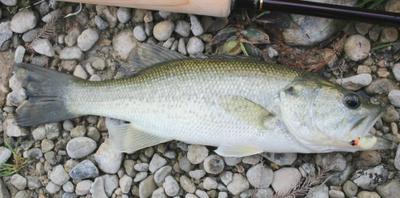As the Worm Turns: Fish-Off between Mummy Worms and Live Butterworms
by John Evans
(San Antonio, TX)

Live Butterworm Surrounded by Three Mummy Worms
For several years, my wife and I have used live Butterworms as bait in our keiryu fishing with good results. Butterworms (usually spelled as one word) are the larval stage of a Chilean moth (Chilecomadia moorei) that are treated before being imported into this country so that they do not pupate into the adult stage. These worms are highly attractive to many species of fish, including panfish, catfish, and bass. They are especially effective for stocker rainbows and will often outfish any other live bait that is used. In our experience they tend to be somewhat better in cooler weather than hot weather. They are orange-ish yellow in color.
One of the main advantages to Butterworms is that they are easy to keep and clean to handle. (Many people find “worm goo” to be a real turn-off!) We usually buy the worms in bulk from one of the major on-line auction sites and then keep them up to three months in the refrigerator with absolutely no care. You don’t have to feed or water them at all. They stay on a hook well, and you can often catch several fish on the same bait. Plus, they come packed in a dry, sawdust environment that doesn’t stain your hands or rod. You can just put them in a bait box when you go fishing, and they’ll last for a morning with no problem. They also have what I would call a “citrusy” smell that is easy on the nose.
Butterworms are just an excellent bait in many respects. About the only negative I can think of is that they are more expensive than red wigglers or even some nightcrawlers. Even in fairly large quantities, they run about 20 cents apiece, with the shipping thrown in. My wife and I have given many of them away at bankside and on the river when fellow anglers asked us what we were using. On a scale of 1-10 for live bait, I’d rate them a 9. They’re consistent producers for a wide variety of fish under a variety of circumstances.
Recently on the TenkaraBum.com website, Chris Stewart introduced “Mummy Worms,” which also seem like an attractive option. As I understand it, these worms are "mummified" or preserved, wax worms, which are also attractive to many species of fish. Because they are not alive, they have a long shelf life and are easy to carry with you. Again, the price is going to be higher than common live worms—about 25 cents apiece, counting shipping, if you order several containers at once. They come in several bright colors and are packed about 35 to each small, plastic container.
I decided to do a little fish-off between live Butterworms and some of the Mummy Worms from France that I ordered from Chris. I went to two different sites on two days—Cibolo Nature Center near Boerne, TX and Blanco State Park in Blanco. I fished with both kinds of bait for an equal length of time, using a Nissin Royal Stage Honryu 330 and a Suntech GM Suikei Special 27.
What were the results?
Both baits performed extremely well. I was able to hook and land a variety of panfish, several largemouth and Guadalupe bass, a number of catfish, and some stocker Rainbow trout in Blanco. The live Butterworms and preserved Mummy Worms were equally attractive to the fish. This surprised me because, in my experience, live bait almost always outfishes any kind of preserved bait. All species of fish eagerly struck and held on to both types of worms. I used a single brass or glass bead on the nymph hook to get the worms on the bottom.
I did learn one trick with the Mummy Worms. I tried several hook sizes and methods of hooking to see what worked best. I finally determined that threading the Mummy Worm head first on to a wide-gap, scud-style hook in size 12 was most effective. (Think Daiichi 1120 or Kamasan B110.) I threaded the whole body of the worm onto the hook and left just the tip of the point sticking out the side. Using this method, I was able to land three catfish on a single Mummy Worm, and catfish are not easy on any kind of bait!
The final verdict? As you can tell by the accompanying photos, a large Butterworm is bigger than a Mummy Worm, plus they stay on the hook a little better and are a little cheaper. Mummy Worms are more convenient and come in a variety of colors. Both types of worms catch lots of fish and both deserve a place in a keiryu angler’s bait box. I really like the fact that both worms are clean to handle and relatively odor free. You can easily slip a container of Mummy Worms into your shirt pocket or day pack and not have to worry about running out of bait again. They would also be good to bring along if you’re introducing an angler to tenkara or keiryu-style fishing to insure some bites. I plan to carry both with me when I keiryu fish from now on and would encourage you to give them a try.
Return to Your Keiryu Stories.
“The bitterness of poor quality remains long after the sweetness of low price is forgotten” - Benjamin Franklin
"Be sure in casting, that your fly fall first into the water, for if the line fall first, it scares or frightens the fish..." -
Col. Robert Venables 1662
As age slows my pace, I will become more like the heron.
Warning:
The hooks are sharp.
The coffee's hot.
The fish are slippery when wet.
Beware of the Dogma
Currently processing orders that were received Mar 8.








